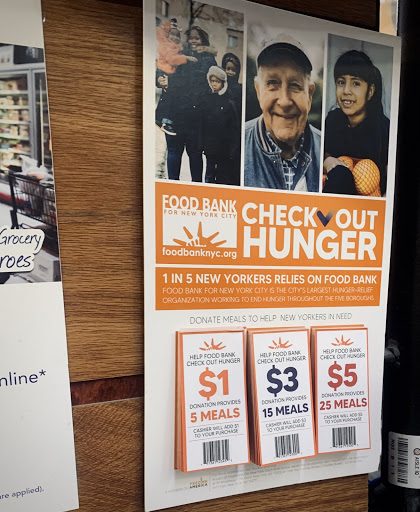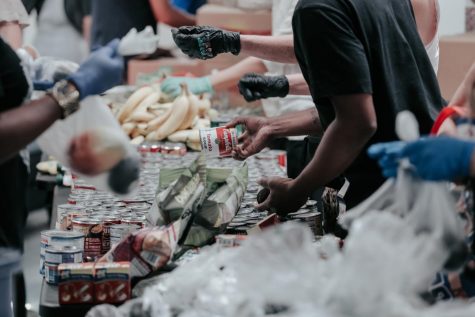Fighting Food Insecurity During the Coronavirus Pandemic
1 in 5 New Yorkers now rely on food banks. What can we do to help?

Flyers from the hunger-relief organization, Feeding America, can be seen at the register of a local grocery store in New York City.
The sun has barely begun to rise, but the line to receive food from the Food Bank of New York City already stretches down the block, with no end in sight. Before 2020, this would have been a rare sight. However, because of the global Coronavirus pandemic, this has become the new reality that thousands of Americans face each day. In New York City alone, around 1.4 million people are currently grappling with food insecurity, according to the Food Bank of NYC.
For many other countries around the world, the food crisis is nothing new. According to the Global Report on Food Crises, in 2019, 135 million people from fifty-five different countries and territories were in urgent need of food assistance, numbers that have been on the rise since the 1990s. Even before COVID-19, more than thirty-five million families were struggling with food insecurity. Since then, the pandemic has only exacerbated the situation.
The Department of Agriculture defines food insecurity as “a lack of consistent access to enough food for an active, healthy life.” Recently, Feeding America, the USA’s largest domestic hunger-relief organization, announced that because of the pandemic, 1 in 6 Americans could face food insecurity. Consequently, the need for food banks has also skyrocketed, with more than 80% of food banks reporting a significant increase in the number of people served in the past year.
While organizations like Feeding America have been fighting hunger for decades, they are currently operating under unprecedented circumstances. Food distribution centers that previously served only a few people a day are now struggling to provide aid to droves of people who have been left jobless and/or homeless by the pandemic. For many, this year marked the first time they sought assistance from hunger-relief organizations. From March through June 2020, about 40% of people visiting food banks reported they were there for the first time.
Unemployment from the pandemic has been the driving force behind food insecurity. Between February and June 2020, almost 16 million Americans lost their jobs and now must rely on food banks and pantries for food. However, meeting this increased demand is proving difficult for hunger-relief organizations.
The price of maintaining non-profit hunger-relief organizations has increased; according to the Good Shepherd Food Bank, the general price per pound of food has increased by 26%, from 87 cents to $1.10. This may not seem like a significant increase, but consider this: Feeding America served about 4.2 billion meals worth of food between March and October 2020. Those 23 cents add up quickly, pushing food banks to their limits. Additionally, there are other expenses that must be paid, including the water and electricity bills of distribution centers, as well as the cost of more boxes and tape to store and distribute food.

Despite the circumstances, hunger-relief organizations are doing their best because for some, these organizations are all they have. “I think food banks are especially important now because there are now a lot more people depending on them for help,” said Jerry Li ’24.
Currently, two thirds of Feeding America’s two hundred food banks are accepting volunteers to help out with distributing food. It is easy to think that we are helpless in this dire situation, but in reality, if more people donate, volunteer, and spread the word, hunger-relief organizations will stand a much better chance at meeting the increased demand.
Understandably, asking people to donate while the Coronavirus pandemic is still ongoing is tricky, since many people are themselves struggling to make ends meet. Still, even a $1 donation to Feeding America is worth up to five meals — anything and everything you can spare makes a difference in improving someone else’s life. Simply spreading the word about the food crisis or promoting your local food banks are steps that can be taken to improve the situation.
If you would like to donate to Feeding America, you can do so here. You can also donate to the Food Bank of NYC here. Remember, no donation is too small, and every bit helps. There is still hope for a bright future, but we all have to play our parts and help to build it.
“I think food banks are especially important now because there are now a lot more people depending on them for help,” said Jerry Li ’24.
Katrina Tablang is a Copy Chief for 'The Science Survey.' She enjoys journalistic writing because it enables her to explore a wide variety of perspectives...
